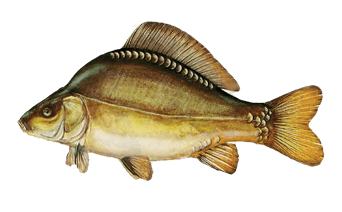
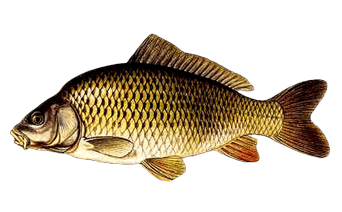
Common Carp
(Cyprinus carpio)
A whole fish family was named after carp. Its Latin name is Cyprinus carpio and the fish of this family are called Ciprinidae. Even certain types of lowland waters, which run very slowly, are called cyprinid waters. In this family there are hundreds of species of different fish that live in Southern Europe and fresh waters of Asia, America and Africa. Their common characteristic is that they have no teeth in their mouth, but have several pairs of pharyngeal teeth placed in the posterior part of the buccal cavity, which grind the food pushing it to the larynx.
There are two types of common carp in these areas: river (wild) carp and pond carp. They differ in body structure; the pond carp has a more compact body and higher back then the river carp. In the ponds there are many scaly carps and also scaly carps which have many large scales on the flanks, and carps with few scales which have linked scales on the back aligned from head to tail and few irregularly placed scales in the tail area, and finally mirror carps which are completely without scales.
The carp inhabits standing and slow flowing waters. It is spread in Europe and Asia. In these areas it can be found in all basins.
The carp spawns mostly in May and June, and if the year is cold spawning prolongs. The carp reaches its sexual maturity at the age of three. It can lay a great number of eggs, but also has many enemies endangering those eggs. The male and female look for adequate spawning spots – shallow places covered with vegetation. The female lays eggs in reed and grass, and the male follows and fertilizes the eggs. Within 2 – 3 days the larva hatches, which grows fast, so until autumn they grow to 0.05 – 0.1 kg. In the second year they weigh 1 – 1.5 kg, in the third year up to 4 kg, and in the fourth year they can even reach 4 – 7 kg. The carp appears to be a good hearted fish, but is very cautious and adept in danger. If it is caught in the fishing net it will try to escape under it or even jump over it. Carps remember spots where they get food, they are tough and resistant, which is why they do not die easily, not even without water. They are hunted in different manners and with different baits; worms, bread, corn mush, corn and with modern and sophisticated methods as fishing with “boil”.
The best time for carp fishing is in the morning and in the evening, when they are in shoals searching for food. Best time of the year is between July and October.
The carp prefers quiet and deep spots in ponds and rivers. During heat periods it retracts into shade or under the pond lilies and aquatic plants close to water surface. In Croatia a carp can grow to a weight often more than 20 kilograms.
The carp is a fish which will come every day to a certain spot if that is where it finds food. That is why fishermen that are going after carp are to feed it for a few days prior to fishing at the place they wish to fish.
Carp’s meat is tasteful, but it can also be fatty, smelling like mud. In order to lose the smell, the carp should be placed in clean water.
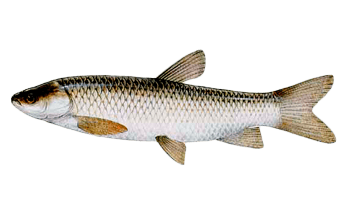
Grass Carp (Amur)
(Ctenopharyngodon idella)
The grass carp is a species of the order Cypriniformes, suborder Leuciscinae. It was named after an Asian river called Amur, a good part of which is a borderline river between the former USSR and China. The grass carp inhabits upper and middle flows of that great river. In China it inhabits the Yellow and the Red Rivers. Those rivers are fast in their upper flows diffusing downstream and flooding great surfaces. The female lays eggs in the fast flows and the river takes it on the surface downstream to the areas where the water temperature is higher than 20 °C which is necessary for the eggs to hatch and develop. She lays between 30,000 and 800,000 eggs which, fertilized, go downstream on the water surface.
The grass carp is a beautiful and well shaped fish. It has a rather wide forehead and large and beautiful scales. Its back is dark olive, a bit darker on the flanks with a white belly. The dorsal and the caudal fin are darker and the others are lighter. It can grow up to more than a meter in length and weigh more than 3 kg. The fry feeds on plankton, larva and small crabs. When it grows it passes to vegetation. It grows rapidly. In the sixth year it can grow up to 5 kilos.
The grass carp was transferred to the European part of the former USSR and further to Romania, Bulgaria and Hungary. Some forty years ago, the grass carp fry was transferred from Hungary to certain fish farms of the former Yugoslavia where its breeding started, alongside the common carp.
It feeds on aquatic vegetation: reed, duckweed, pond-scum, waterweed, sedge, and even grass clover if it wants. It is a fast growing herbivore.
The grass carp eats a daily amount of aquatic vegetation almost as much as it weighs. It is often used in ponds as a “cleaner” of water surfaces covered with vegetation.
Its meat is delicious. However, there is a problem of spawning in our climate conditions, but artificial spawning shows results.
The time of its natural spawning is in the period when our rivers do not have the required warmth for its spawning. So the only way to spawn is artificially in hatcheries.
The grass carp is resilient to some carp diseases, even though it belongs to that family. It has an exterior very similar to a chub, although the difference can easily be noticed as it has a significantly smaller head. In the former USSR the grass carp became a sport fishing fish as well, so it was cultured in some open waters.
In these areas the grass carp became closed waters inhabitant, usually in the common fishing grounds, rich in aquatic vegetation.
Sport fishing hunters use reed for catching grass carp, but they also use, as in catching a common carp corn, corn mush and more modern and sophisticated methods such as using the “boil”. It is a feisty fish which, when it feels caught, fights fiercely.
As it can be seen from the aforesaid the grass carp is an excellent economy and sport fish which is becoming more and more present in our waters.
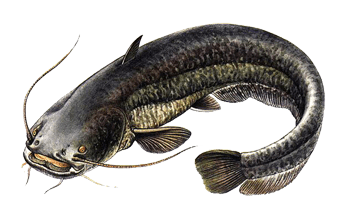
Catfish
(Silurus glanis)
The catfish is the only European representative of this numerous family. It has a large head with big mouth and small teeth. Its head is wide and flat and its eyes are small and tiny. It has two long barbels on the upper jaw and four shorter on the lower jaw. Its body is bare and slippery and gets slimmer and flatter towards the tail. It has a long anal fin that extends to the caudal fin, and a small dorsal fin. Its upper body is grey-olive-green and dark, and its belly is dusty white. It is often covered with irregularly shaped spots. Beside sturgeon and beluga it is one of the largest freshwater fish and it can weigh over 300 kg.
It inhabits large rivers of the Central, Northern and Eastern Europe. In our areas it can be found in the Danube basin. The catfish lives alone and does not travel in groups. It sticks to quiet deep spots in the holes in the middle of the river, or near the banks under the chucks and clogs.
It spawns from May until July in shallow waters. The female lays sticky eggs on the aquatic plants. Then the male and the female meet and swim together. If the water level is favourable the young catfish grows fast. The catfish is a night predator, although it moves during the day when the water is muddy and high. It is well known that the catfish will start its search for food in the summer during heavy storms, showers and thunder. When it starts its search for food, it can swim in the strongest currents and it will go to shallower places.
The catfish is a voracious omnivore attacking everything. It is caught on solid and strong tackle, thick lines and big hooks. At night a pile of worms, leeches and live fish are set as bait. If it is fished with lures, thicker lines and small heavy lightning lures should be used that should be kept near the bottom where the water flows from the shallow spots to the depth.
It can also be caught on a so called “whisk”. A fisherman lets the water carry his dingy through the middle of the river while he is holding a solid rope with a mole cricket or a small fish, and at the same time with wooden whish (something similar to an upper part of the bottle) he churns the water, making sounds that can be heard for hundreds of meters. The catfish approaches the sound, sees the bait and grabs it. It depends on the fisherman’s skills and the size of the catfish whether it will be taken out of the water or not. It can also be caught on frogs, shelf, chicken intestine and similar baits. If the catfish grabs the bait, it usually swallows it together with the hook. In the water it is strong and feisty, so it takes a lot of effort and time to take it out of the water. This requires slow and patient manoeuvring until the catfish gets tired, to then pull it out, because forcing can result in losing the catch. Using gaff is recommended when pulling the catfish out of the water. It does not like the cold, so in the wintertime it stays buried in the mud. When the spring muddy waters rise, the catfish rises from its hibernation as well. The catfish bites best during the summer until the beginning of the winter.
Its flesh is excellent with a very few bones.
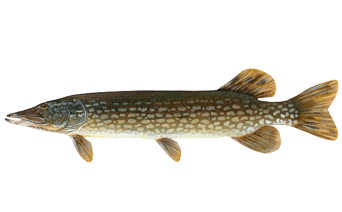
Pike
(Esox lucius)
Its body is adapted and built to be able to swim fast and catch its prey. It is long and thin, with a flatted head while its mouth is spiky with sharp teeth turned inside, so when it grabs a fish it does not let go. It is greenish with white-yellow spots, and its scales are tiny. It has a white belly and green back; its eyes are protruding and its dorsal fin is placed well in the back. When swimming fast its pelvic and pectoral fins are pressed close to its body. It can grow to 15 kg. It inhabits the upper layers of water, where it preys for small fish. The pike can be found almost everywhere in Europe, except in Spain and south Italy. The pike is primarily a fish of North America, and in Europe of Scandinavia, Russia and Siberia. It is also spread in Asia.
The pike is a well-known fish, inhabiting mainly slow rivers. They are most numerous in ponds, pot-holes and still backwaters.
In Scandinavia and Siberia it can grow over 2 meters and up to 30 kg.
The pike spawns from February until April on the shallow shores covered with the aquatic vegetation, and the female is joined by one or two males. The female can lay up to 100,000 eggs, 3 mm in size. They hatch in 2-3 days, depending on the temperature, but most of the larva gets eaten by the pikes. The pike is suitable for artificial breeding in ponds. It feels movement of small fish better with its lateral line than with its eyes. It has been noticed that it reacts to the colour red, so it is more likely to attack lure with some red rope on the tail than one without it. The pike lives near the grass, pond lilies, and clogs where it preys small fish. In the last few years the pike in these areas is protected during the spawning season, because it often gets caught on the lure, due to its greediness, so if this species was not preserved there would be a danger of decimation.
It is not rare that the pike gets caught on the lure and still has a tail of a recently caught and devoured fish in its mouth. For us, sport fishermen, the pike is a very interesting glutton which gives us a lot of pleasure. It grows fast, and in favourable conditions it can reach 300 g in the first year and in the second year almost 3 kg. In the following years in can grow even faster. It attacks everything in the water except slugs and, allegedly tench. The pike usually goes hunting for small fish at the end of the day during winter and early in the spring, and much later in the summer. Later in the day and early in the evening it will go searching for food all year long. It goes to places and shallow waters where there are minnows and smaller fish, especially watering places, to the shores or stronger currents where the smaller fish swims with difficulties. It will grab a frog or a mouse if it sees one. It is fished by lures, “raub” or “bottom” with live bait. It can rarely be caught on worm, especially if the water is muddy. When fishing a pike it is best to use a larger lure (10-12 cm together with a treble hook on the tail). In clear water it is best to use a yellow lure, and in the muddy water it is best to use a silver-white one. A bit larger Mepps, number 5 or 6, is good. A stronger line should be used. In deeper waters it is best to fish with Copf to which the pike can easily get caught. As a leader for pike fishing it is good to use a thin metal thread or ready-made wire leaders because the pike often bites through the line. Good results can be achieved by lure fishing with a dead minnow attached to a so called “system”. When fishing with lures or dead bait the “system” needs to be pulled so the pike would not get to close.
It happens quite often that the pike follows the bait without attacking it. Then the lure should be speeded up, and by no means slowed down. If we slow down the movements of the lure, the pike will certainly not bite because that is not the way the bait behaves in reality. If speeding up, the chances of bite are 50:50.
When using the technique of “raub” it is necessary to know the waters where we fish. The fishbait should be placed an inch or two from the bottom near the shallowest spot where a large pike could be located, due to its sluggishness. When a pike grabs the bait on the “raub” it usually grabs it diagonally, and then turns it in the mouth and swallows.
It does not always have to be like that, but in most cases it is. When the pike grabs the bait, the cork will sink. Fishermen are making a mistake if pulling the “raub” when the cork sinks. As soon as the pike feels the resistance, it attempts to throw the bait out from the mouth and swim away, and we lose our catch. After the first sinking of the cork, or after the first movement of the cork, it is necessary to wait. The cork will quiver on the surface and after that if the pike turns the minnow and starts to swallow it, the pike will swim to the bottom – that is the moment when it should be pulled. The scenarios are different – many times it can pull it right after the cork sinks if there is a treble hook to which the pike’s mouth could get caught. It is necessary to carefully unhook a caught pike because we could easily hurt our hand with its sharp teeth. It is best to use pincers for extracting the hook.
The pike that lives in pure and clear waters is excellent for eating and its flesh does not taste like mud.
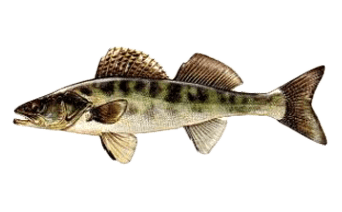
Zander
(Stizostedion lucioperca)
Its body is shaped like a cylinder, thin and elongated. Its dorsal fin is split in two parts; its scales are small and firm. Its back is darker, and its sides are greenish with 8-12 dark lines, its belly is whitish. Its dorsal fin and caudal fin have dark spots, and other fins are greyish and spotless. Its teeth are sharp, but smaller than pike’s, its mouth is also smaller and the larynx is narrow. This is why it will attack smaller fish than pike. It can grow up to 15 kg. It inhabits rivers of America and ponds throughout mid and eastern Europe and Asia. It can be found in Finnish lakes to 64° north geographical latitude and in the Asian rivers of the Black Sea basin, Caspian Sea basin, the basin of the Sea of Azov and the Aral Sea basin. In these areas it inhabits the Danube basin and the lakes of Pannonian basin.
Zander prefers deep, clean and running water and gravel bottom. It lives in muddy waters (Danube) as well. It does not prefer soft muddy ground, nor to fast or to cold rivers. Water temperature that suits it is between 10 and 18 °C.
It spawns from April until June, and the female lays sticky eggs on the aquatic plans. Its eggs are smaller than the ones of European perch. The male stays with the fertilized eggs for some time. The juvenile fish feeds on animal plankton, but after one year it stars to attack and eat smaller fish. It is best to hunt the zander from August until November in the morning and in the evening. The zander is timid and usually moves during the night. The way to catch it is with a small fish and tackle. When pulling the lure it is necessary to keep it at the bottom and choose less heavy and thin lures. One treble hook is sufficient. It is not necessary to use metal leaders. The zander is a sensitive fish and it is easy to pull out once it is caught. In zander fishing using cut fish has proven most successful. This is probably because the smell of blood attracts the zander which has an excellent sense of smell. It is necessary to use heavier sinkers, depending on the water current, in order for a bait to stay near the bottom, and also a longer leader tied with a swivel and a hook at the end. On the hook a half of minnow should be placed so the tail is facing upand the hook is stuck at the end of the half of minnow, but the point of the hook should not be visible. The most common way to fish a zander is with a light float and live fish, but only for waters where the currents are not too strong. The float needs to be light so the zander can easily pull it under the water, because when it feels stronger resistance it will immediately let go of the bait.
The zander flesh is excellent with a very few bones, and is a popular and expensive fish.
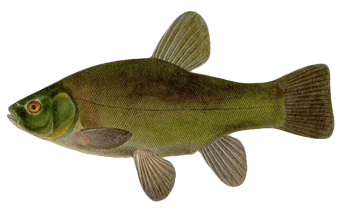
Tench
(Tinca tinca)
Its body is very thin and its tail is short and firm without a significant notch. Its mouth is narrow with a very small barbel at each corner. The tench has very small scales and its skin is thick and slippery. Its lateral line is thick, slightly elevating to the head in the front part. It has an olive-green or dark olive-green back, and its flanks and belly are greenish or golden, depending on the colour and clearness of the water it lives in. It inhabits stagnant and running waters of Europe, rich in vegetation, mud and clay.
It can weigh up to 2 kg. It spawns from May until June and lays eggs on the aquatic plants. During the winter it stays buried in mud and it belongs to the fish species that can live in the water with a low percentage of oxygen.
It feeds on small animals and molluscs from the bottom, like common carp. It feeds intensively only during the summer, and in the winter in eats what it had caught during the summer.
It is a rather calm fish. It can be caught with a tackle similar to the one used to catch a common carp, with a float, usually in the spring time, and slowly and cautiously it will take up a worm.
The clearer the water, the closer to the middle of the river bed will the tench go, otherwise it will hide in weed and aquatic vegetation. When caught it is fierce, so it should be pulled with a solid equipment.
Its flesh is fatty and tasty, especially when it lives in running waters since then it does not taste like mud.
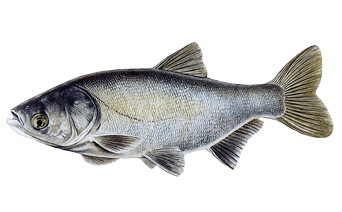
Silver carp
(Hypophtalmichthys molitrix)
Its body is thick and its head is wide. Its eyes are placed low. The silver carp has a sharply keeled belly from the throat to the anal fin. Its pectoral fin goes to the pelvic fin. Its back is grey-greenish and the flanks are silver. Silver carp can grow to 1 meter in length and to 20 kg in weight. In the south they are mature enough to breed after 3 years. It spawns in the summer from June until August, when the water temperature is between 26 and 30 °C. In Croatia it spawns only artificially in hatcheries (like bighead carp). Its homeland is, like grass carp’s, Asia and China.
The female lays over 500,000 eggs, which are, like grass carp’s, non-adhesive and float in the water. The fry feed on zooplankton and as they grow older, they start feeding on plankton alga. There are many breeding possibilities of silver carp and it is more and more bred in the ponds in Croatia. Bronchial spines are grown together and form a type of a net. In ponds and standing waters they will bite at grain food, worm or larva.
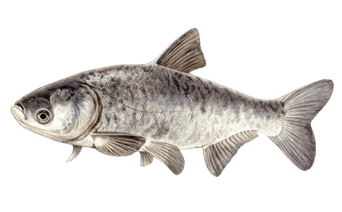
Bighead carp
(Aristichthys nobilis)
It differs from silver carp because it does not have a keeled body, its head is larger and it has a darker body. On the flanks it has dark irregularly shaped spots. It grows faster that the silver carp and feeds on zooplankton and plankton algae. Its flesh is, like the flesh of the silver carp, excellent. Its homeland is China and it was introduced to fish-farming in Hungary in 1963, and so it reached to fish-farming in Croatia.
In Hungary it becomes mature for breeding at the age of six or seven; however it spawns only artificially, because for natural spawning it requires high water temperatures, same as the silver carp. It can get caught on a worm, but it is necessary to use a solid tackle. Our fishermen plant its fry in the community ponds. In Croatia it can grow up to 20 kg and in its homeland up to forty.
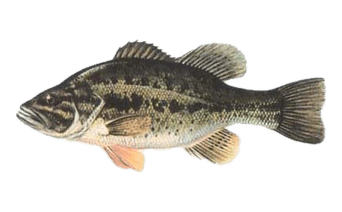
Largemouth bass
(Micropterus salmoides)
Largemouth bass is grey-greenish with a dark back and a lighter belly. Along each flank and on the back it has irregularly shaped blackish spots. It has a large head. It spawns in May and June when the water temperature is about 16 °C, in shallower places. The adult female has, depending on her size, from 2,000 to 20,000 eggs. Eggs and hatched fingerlings are watched over by the parents. It prefers standing or slow flowing warmer waters. Its homeland is freshwaters of the North and Middle America.
It was brought to fish-farming in Croatia about hundred years ago. It was escaping from the ponds to open waters and when its farming in ponds stopped, some 60 years ago, it vanished from open waters. It was reintroduced from France as fry thirty years ago, and put in some Croatian fish-farming. It can be found in the backwaters of Drava, if it is coming from Hungary where it is being bred. It is caught in the summer; it bites best in the morning and in the evening when the water temperature is between 18 and 23 °C. It can be caught on mepps and other modern lures and is very fierce. In America it can grow to 10 kg and in Croatia to 2 kg.
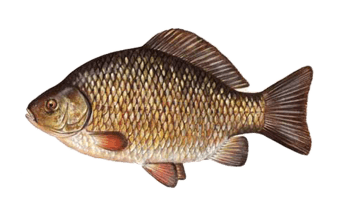
Prussian carp, Crucian Carp
(Carassius Auratius Gibelio)
The Prussian carp became one of the most widespread fish of Croatian waters. It came to these areas in the late 70s of the last century.
Its homeland is China, from where it spread to the waters of the wider area of East Asia and Siberia. It was brought to the European part of the USSR in 1948, after which it spread fast to the east; from an almost unknown fish species it became an invasive species with a large population.
Its population is growing ever since, at the expense of Crucian carp, with whom it can breed, and the common carp is at risk as well. There is no closed season on the Prussian carp, because of the large population.
The average weight for hunting is 300 – 500 g, but occasionally Prussian carps of 2-3 kg can be caught.
The Prussian carp is a fish of the bottom where it feeds on plants and animals. It owns its distribution to special characteristics; resilience to the unfavourable conditions (low oxygen in the water, high temperature changes).
It is capable of surviving in freezing waters, and it can bury itself in the ground, like Crucian carp, and survive a complete lake or pond draught.
Habitat and Behaviour
The Prussian carp prefers standing waters with lots of aquatic vegetation. Aquatic plants are its natural shelter from the various enemies, and this environment is also very rich in food. In waters with less aquatic vegetation the Prussian carp stays away from the shore in the depth and on the bottom. Apart from the freshwaters, the Prussian carp can be found in brackish waters (Adriatic Basin Rivers).
Feeding
The Prussian carp is an omnivore. It feeds mostly on invertebrates which it finds on the bottom and aquatic vegetation. During the winter it stops feeding and starts hibernating. Beside the food it finds in its environment it will eat everything that is thrown in the water: bread, corn, wheat, worms, maggots…
The Prussian carp feeds on the bottom, which is where it should be hunted. Firstly, it is necessary to find a shoal, according to the bubbles that appear on the water surface. In the morning and in the evening they come closer to the shore and feed on coastal plants, during the day they should be looked for away from the shore in the depth.
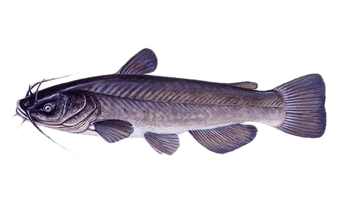
Brown Bullhead
(Ictalurus nebulosus)
It was brought to Europe from America, namely in Croatian waters, over 70 years ago. It is also widely known as the "mud pout", "horned pout" or "hornpout" or simply "mud cat"...
It can be found in all lowland waters so it was transferred to many swamps, puddles and marshes. If it, by any chance, comes to ponds, it is a menace for fry and eggs of other fish, especially tenches’. It is extremely resilient. During dry periods all it takes for it to survive, and await rain and water, is a little bit of mud. It can go for days without food. It can bear frost and cold very well.
Its body reminds of the body of catfish, but it a completely different species which is visible from many aspects. In these waters it barely ever reaches the weight of 600 grams, it has for pairs of barbels on the head, and on the back fatty fins, characteristic for salmonidae fish, however the brown bullhead does not belong to the family of salmonidae. Its skin is smooth without scales, marble grey or dark, depending on its environment, and its belly is dusty white. On the fins behind its head and on the back it has a sharp spike that should be watched out for. When it stings, it causes intensive pain and bleeding.
It lives in shoals. It spawns in May and June. The female lays up to 13,000 eggs in specially prepared nests. Although brown bullhead is a predator, it carefully looks after its fry.
The brown bullhead is a bottom fish and looks for food mainly during the night, but it can successfully be caught during the day. It takes the food even when it is not hungry. It grabs a bait roughly and greedily, devouring the hook. When being pulled out it resists. It is easy to pull it out of the water, since it is a small fish. The brown bullhead of 300-400 grams is considered a good catch. Its flesh is tasteful whether fried or baked. It is excellent for a fish stew, because its energy value is high.
When caught, in hands the brown bullhead makes sounds like sizzling and gnashing. At that moment its fins with sharp spikes are bristling and ready to stab. So it is necessary to carefully take it from the hook. It is fished with light tackle and small hooks, without floats, in depth, with sliding sinkers.
Baits: red and rain worms, slugs, bits of fish and fresh or dry meat, crab tail bits, small fish, bacon and small leeches.